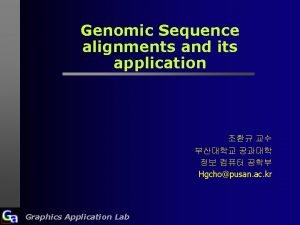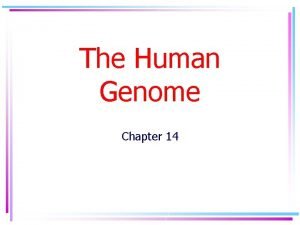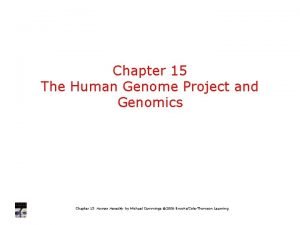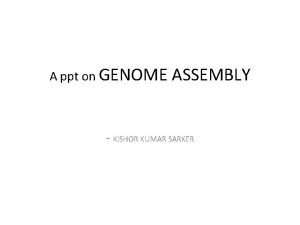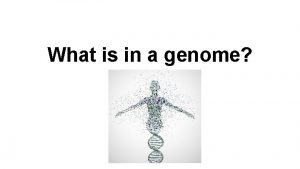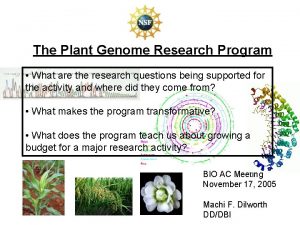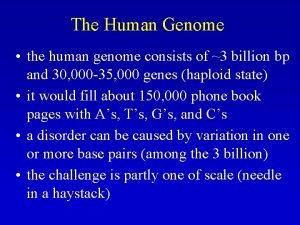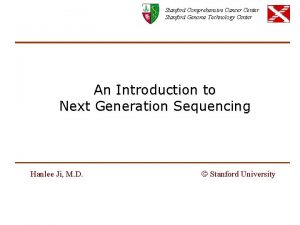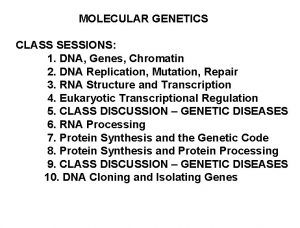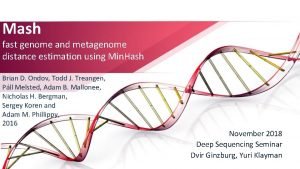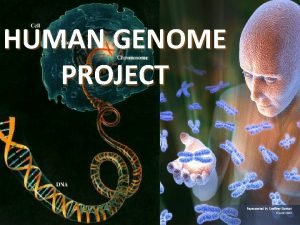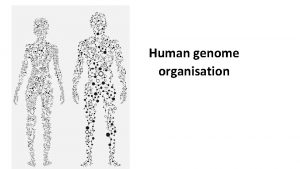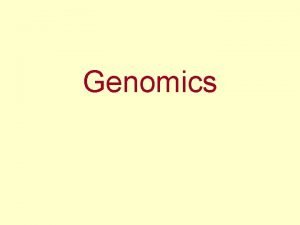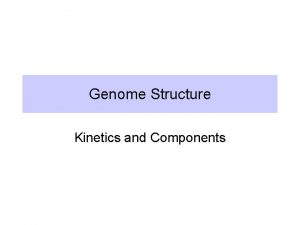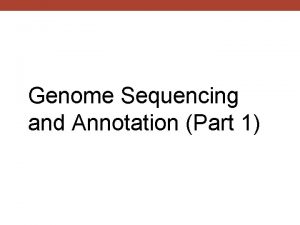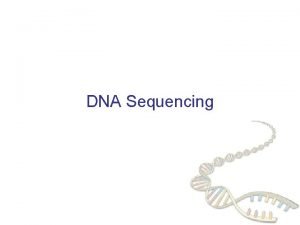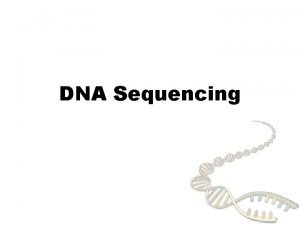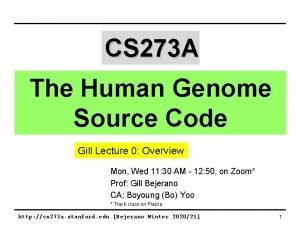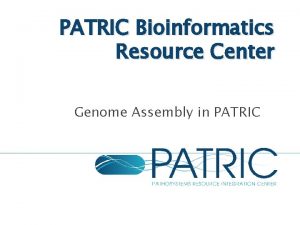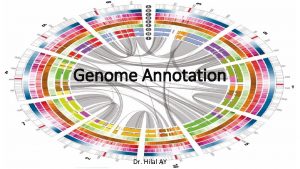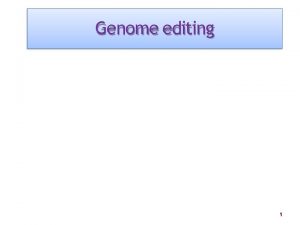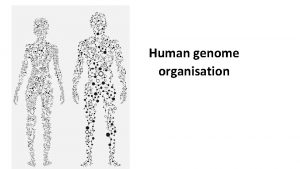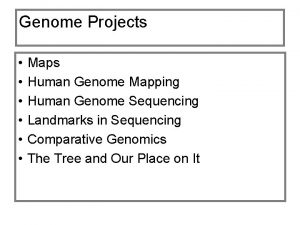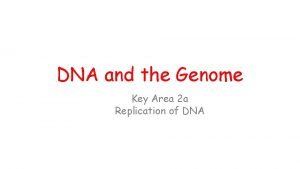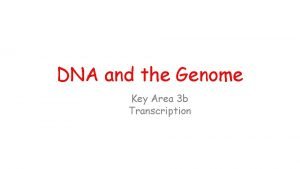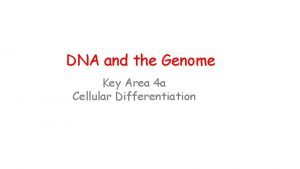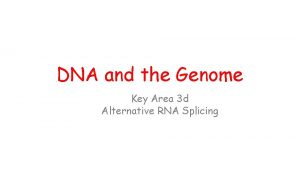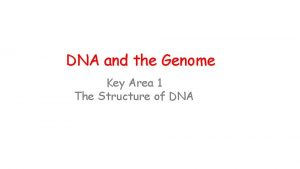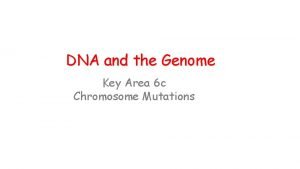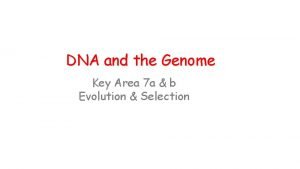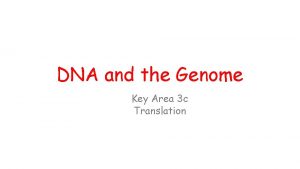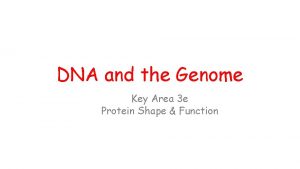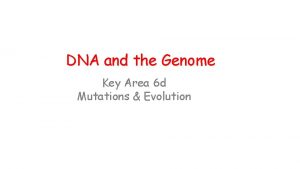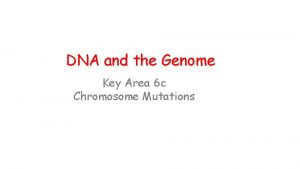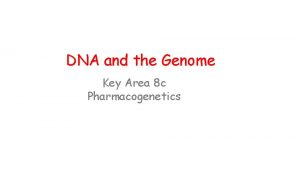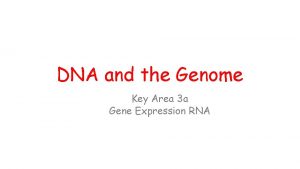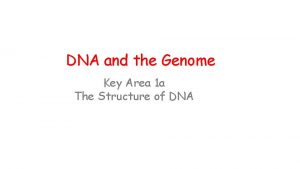DNA and the Genome Key Area 6 a



























- Slides: 27

DNA and the Genome Key Area 6 a & b Mutations

Learning Intentions By the end of this topic you should be able to: (a) Mutations Define ‘mutation’ and describe the effect of one (b) Single gene mutation Define ‘single gene mutation’ Name 3 single gene mutations Describe 3 single gene mutations Name 3 single-nucleotide substitutions Explain the difference between missense, nonsense and splice-site mutations Describe the effects of missense, nonsense and splice-site mutations Describe 2 possible effects of nucleotide insertions or deletions

Mutations

What is a mutation? A mutation is a change in the DNA that can result in no protein or an altered protein being synthesised There are two main type of mutations: Single Gene mutations a change in the order of bases on a strand of DNA Chromosome mutations a change in the chromosome structure If a mutation causes a change in phenotype the individual is called a mutant

Mutant Alleles Mutant alleles are random, spontaneous and rare They usually result in one of the following: • No protein being produced • An altered protein being produced Mutations are normally harmful or even lethal but occasionally can be beneficial The rate of a mutation occurring can be increased by mutagenic agents such as radiation, cigarette smoke, UV light and high temperatures Most mutations are recessive and they are the only source of new characteristics which drive evolution forward

Single Gene Mutations Single gene mutations involve the alteration of a DNA nucleotide sequence. There are three types of gene mutation: • Insertion of nucleotide(s) • Deletion of nucleotide(s) • Substitution of nucleotides If in an exon, the result of these mutations is that 1 (or more) codons and therfor 1 (or more) amino acid(s) is altered which causes a change in the protein synthesised.

Gene mutations Normal Base Sequence Type of Mutation Altered Gene Code Protein produced Effect of Mutation INSERTION AGATGTC DELETION AGGTC Greatly changed due to frameshift mutation i. e. everything from that point on is altered Non – functional protein e. g. cystic fibrosis SUBSTITUTION AGATTC May only be slightly changed due to a single base (only one amino acid altered) Protein function altered e. g. sickle cell anaemia AGAGTC

Insertion An extra base is inserted to a strand of DNA and all the other bases are shifted along.

Effect on protein produced This insertion results in a frameshift mutation. All of the codons and all of the amino acids after the mutation are changed. This has a major effect on the structure of the protein produced.

Deletion A base is deleted on a strand of DNA and all the other bases are shifted along.

Effect on protein produced This deletion also results in a frameshift mutation. All of the codons and all of the amino acids after the mutation are changed. This has a major effect on the structure of the protein produced.

Frameshift Mutations – Insertion & Deletion These gene mutations are called frameshift mutations and bring about a major change by affecting many amino acids. A completely different protein is produced and so the organism is affected greatly, sometimes causing death e. g. albanism - albino plants can’t photosynthesis so die.


Cystic Fibrosis- Base Sequence Deletion Cystic Fibrosis is a genetic disorder that affects the pulmonary system of those affected. It is caused by a single gene deletion mutation Three bases are deleted in the gene which codes for a glycoprotein (component of mucus) located on chromosome 7 The abnormal protein produced results in abnormally thick, sticky mucus causing congestion and blockages

The cystic fibrosis DF 508 mutation The diagram shows the normal and mutated proteins resulting from this gene mutation The normal protein (CFTR) has phenylalanine (F) at position 508 but the mutant form has this deleted, causing the protein to fold incorrectly.

Substitution One base changed for another on a strand of DNA, one codon affected.

Effect on protein produced Only 1 nucleotide is affected and so only one amino acid in the protein will be affected This is known as a point (base) mutation

Point Mutations - Substitution These gene mutations are called point (base) mutations and can bring about a minor change to the protein: As it only affects 1 amino acid the protein is usually (but not always) still functional and so the organism is only affected slightly or not at all However, it can cause a major defect if the mutation is at a critical position in the protein e. g. sickle cell anaemia Sickle Cell Point Mutation

Types of Point (Base) Mutations Point (base) mutations can be classified depending on the effect they have on the sequence of amino acids in the protein produced. There are 3 main types: • Missense Point Mutations • Nonsense Point Mutations • Splice-site Mutations

Missense Point Mutations The alteration of one base in the codon by a substitution results in one amino acid being changed for another. This may result in a non-functional protein or have little effect on the protein depending on which amino acid is changed. Nonsense Point Mutations The alteration of one base in the codon by a substitution results in the amino acid being changed into a stop codon (UAG UAA UGA) which stops protein synthesis prematurely and results in a shorter than normal protein being made.

Neutral

Splice Site Mutations The mutations we have considered until now are all found in the coding regions of DNA (exons) However, mutations that occur in the non-coding introns can still affect protein function A splice site mutation is one that substitutes, inserts or deletes one or more nucleotides at a site where introns are usually removed from the primary m. RNA

Splice Site Mutations If a mutated splice site is made non-functional, one or more introns may be left in the mature m. RNA and/or some exons will be excluded from the mature m. RNA This will in turn result in the m. RNA being translated in such a way that the protein produced will not function properly

The top sequence shows two exons (in capitals) separated by an intron sequence (lower case) The intron is usually cut out as the enzyme recognises a particular sequence at the start and end of the intron The bottom sequence shows a splice site mutation. As the usual recognition sequence is missing, the intron is not cut out This means the mature m. RNA produced will differ greatly from the normal

Thalassemia, a disease caused by a defect in haemoglobin synthesis, is caused by a splice site mutation. Intron Exon Normal splicing Normal functional haemoglobin with 4 oxygen carrying subunits Abnormal splicing Haemoglobin with only 2 oxygen carrying subunits

Point Mutation - Intron Point mutations can also occur in non-coding regions of the DNA (introns). If this mutation is in a part of the intron that regulates gene expression it can have a major effect on the protein Regulator sequence RNA polymerase ready to start transcription

Point Mutation - Intron Normal protein transcription Regulator sequence RNA polymerase ready to start transcription No protein transcription as regulator does not bind RNA polymerase Regulator sequence mutation RNA polymerase not bound to start transcription
 Genome-to-genome distance calculator
Genome-to-genome distance calculator Sickle cell karyotype
Sickle cell karyotype Human genome project
Human genome project Coding dna and non coding dna
Coding dna and non coding dna Replication fork
Replication fork Bioflix activity dna replication lagging strand synthesis
Bioflix activity dna replication lagging strand synthesis Replication process
Replication process Dna rna protein synthesis homework #2 dna replication
Dna rna protein synthesis homework #2 dna replication Genome assembly
Genome assembly Key patners
Key patners Key partners
Key partners Dna structure and replication packet answer key
Dna structure and replication packet answer key What is genome
What is genome Plant genome research program
Plant genome research program Euphenics
Euphenics Stanford
Stanford Human genome size
Human genome size Mash genome
Mash genome Human genome size
Human genome size Human genome project
Human genome project Vntrs vs strs
Vntrs vs strs Perpartes
Perpartes Repeated sequences
Repeated sequences Hierarchical shotgun sequencing vs whole genome
Hierarchical shotgun sequencing vs whole genome Hierarchical shotgun sequencing vs whole genome
Hierarchical shotgun sequencing vs whole genome Genome sequencing
Genome sequencing Human genome project source code
Human genome project source code Patric genome
Patric genome
